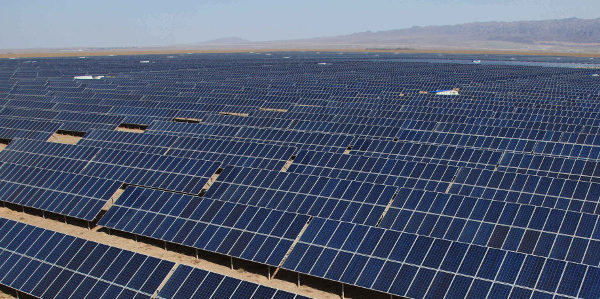EnergyTrend, a Taipei-based research firm, estimates that China’s total grid-connected capacity additions could hit 46.7 GW this year, once the new 5 GW installation quota for Beijing’s Top Runner scheme is included.
The forecast marks a slight decline from the record 52.83 GW that was built in 2017, according to recent statistics from China's National Energy Administration (NEA).
“The Chinese market continues to grow excessively, mainly driven by supportive policy and production capacity expansion,” EnergyTrend says.
PV developers in China will likely rush to install projects at two different points in the year in 2018, in line with recent adjustments to the feed-in tariff (FIT), says the company. The Chinese government’s new FIT rates for 2018 went into effect at the start of this month, with rates for some projects falling by as much as 15%.
EnergyTrend, a unit of TrendForce, believes that the first development rush in China will occur at the end of the first half of the year, as ground-mounted PV projects that were registered with the government before the end of 2017 will be eligible for last year’s FIT rates, if the installations are finished by the end of June 2018.
However, all installations that are registered and completed within the current year will receive the 2018 FIT, which could fuel another rush to complete projects next December.
Over the course of the coming year, shifting deployment trends could see large utility-scale PV projects take a back seat to distributed-generation (DG) installations, EnergyTrend suggests. Roughly 19 GW of DG solar capacity was connected to the Chinese grid in 2017, up sharply from just 4.23 GW a year earlier.
Beijing has revealed plans to continue to support the deployment of DG solar projects, as well as the construction of small PV arrays under its rural poverty alleviation scheme, with tighter requirements looming for utility-scale PV installations.
Annual worldwide PV installations surpassed the 100 GW mark in 2017 for the first time, largely due to explosive deployment in China, where yearly investment reached a new record. The U.S. market came in second, with about 12 GW, EnergyTrend says, followed by India with 9.26 GW and Japan with just 6.09 GW.
Global deployment rose by 26% year on year in 2017, following a 42.5% year-on-year jump in 2016. The Asia-Pacific region accounted for about 72% of the global PV market last year, primarily due to the ongoing expansion of the Chinese market.
EnergyTrend expects global solar deployment to hit 105.88 GW this year, from roughly 108 GW in 2017. Its prediction is broadly in line with other recent forecasts for 2018. It believes that changing regional demand patterns throughout the world will facilitate the deployment of at least 15 GW per quarter,
It also expects to see a recovery in the European PV market. However, the research firm believes that the expansion of the Chinese PV market will start to slow down through the end of the decade, as the European market rebounds and emerges as a key driver for global solar deployment.
It notes how a number of utility-scale PV projects are set to be completed by the third quarter of this year in France, Spain and the Netherlands. It also argues that the expiration of the Minimum Import Price (MIP) for solar components and cells entering Europe from China at the end of September, will facilitate greater competition on the continent.
This content is protected by copyright and may not be reused. If you want to cooperate with us and would like to reuse some of our content, please contact: editors@pv-magazine.com.



By submitting this form you agree to pv magazine using your data for the purposes of publishing your comment.
Your personal data will only be disclosed or otherwise transmitted to third parties for the purposes of spam filtering or if this is necessary for technical maintenance of the website. Any other transfer to third parties will not take place unless this is justified on the basis of applicable data protection regulations or if pv magazine is legally obliged to do so.
You may revoke this consent at any time with effect for the future, in which case your personal data will be deleted immediately. Otherwise, your data will be deleted if pv magazine has processed your request or the purpose of data storage is fulfilled.
Further information on data privacy can be found in our Data Protection Policy.